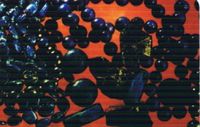Lapis lazuli: Difference between revisions
Jump to navigation
Jump to search
No edit summary |
mNo edit summary |
||
| Line 1: | Line 1: | ||
[[Image:Mu men.jpg|200px|thumb|Mumen]] | [[Image:Mu men.jpg|200px|thumb|Mumen]] | ||
'''Lapis lazuli''' ([[Wyl.]] ''mu men'', ''mumen'') — a precious stone used in [[Tibetan medicine]] and in [[Vajrayana]] practices | '''Lapis lazuli''' ([[Wyl.]] ''mu men'', ''mumen'') — a precious stone used in [[Tibetan medicine]] and in [[Vajrayana]] practices. Some dictionaries identify ''mumen'' with sapphire, but that seems dubious. | ||
According to the [[Great Tibetan Dictionary]] and Tibetan medicine, the taste is astringent, the post-digestive effect is cooling, and it has the ability to bring benefit when afflicted by poisoning, leprosy, diseases related to lymphatic fluid (''chu ser'') and skin disorders. | According to the [[Great Tibetan Dictionary]] and Tibetan medicine, the taste is astringent, the post-digestive effect is cooling, and it has the ability to bring benefit when afflicted by poisoning, leprosy, diseases related to lymphatic fluid (''chu ser'') and skin disorders. | ||
Revision as of 11:15, 2 August 2016

Lapis lazuli (Wyl. mu men, mumen) — a precious stone used in Tibetan medicine and in Vajrayana practices. Some dictionaries identify mumen with sapphire, but that seems dubious.
According to the Great Tibetan Dictionary and Tibetan medicine, the taste is astringent, the post-digestive effect is cooling, and it has the ability to bring benefit when afflicted by poisoning, leprosy, diseases related to lymphatic fluid (chu ser) and skin disorders.